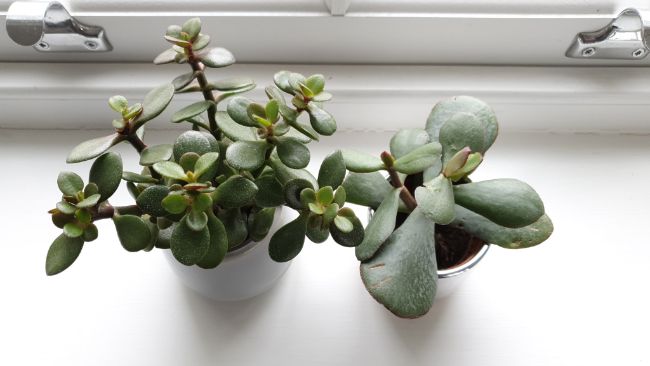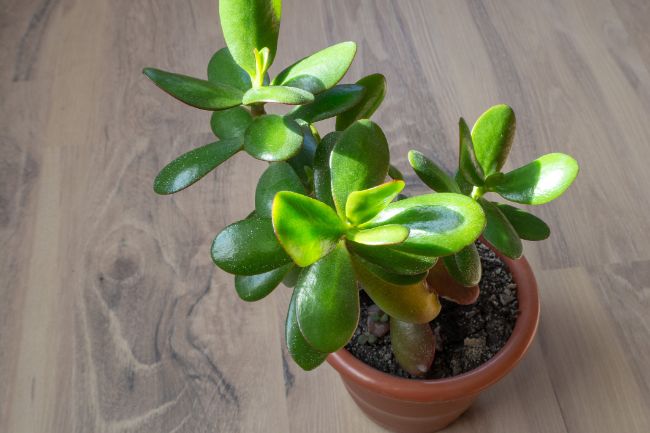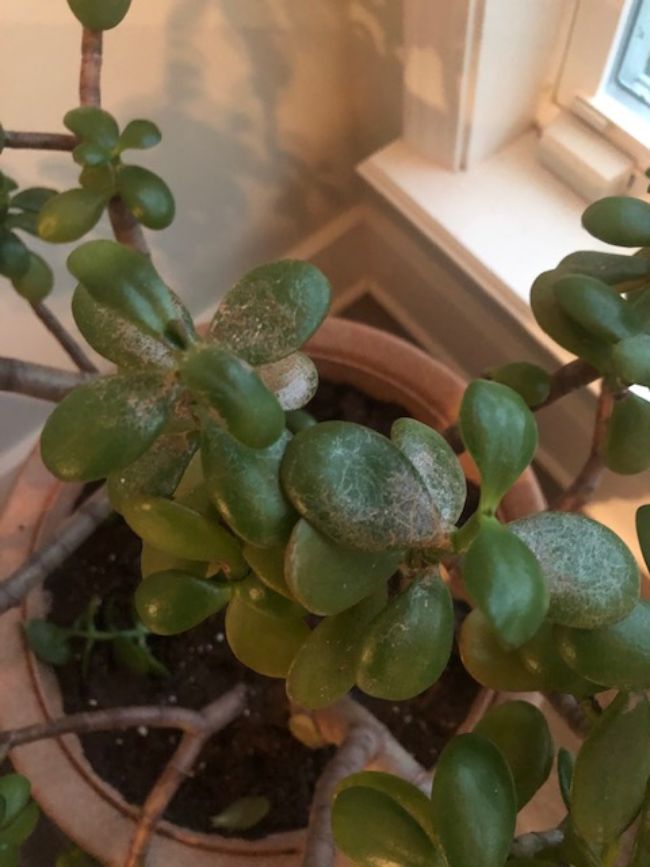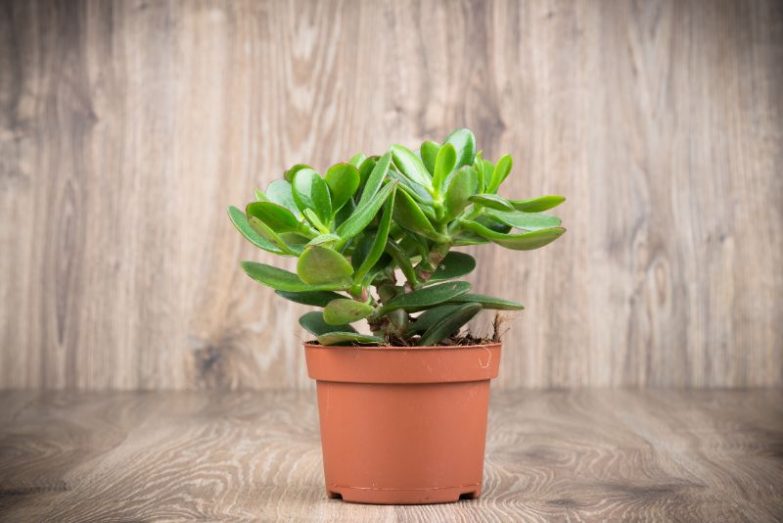Jade Plants are hardy and long-lived favorites of gardeners worldwide. Though they thrive with the right kind of neglect, leaf browning is common and has many possible causes. Let’s look at why your Jade Plant leaves are turning brown, how to return it to health, and how to avoid future problems.
Why are my jade plant leaves turning brown? Though unsightly, browning isn’t always a serious threat. The most common reasons are sunburn and watering issues including edema and scalding by water drops on leaves. Other possible causes are overfertilization, temperature extremes, pests, disease, or even just natural aging.
Jade Plant Overview
The Jade Plant (Crassula ovata) is a drought-resistant, sun-loving South African succulent that originated on rocky hills in a dry climate with sporadic rainfall. It likes to be left quietly undisturbed in a sunny spot with minimal watering, feeding, or fuss.
The Jade Plant’s waxy, fleshy leaves and fat woody stems store water efficiently: they cope with a lack of moisture much better than with wet conditions. Brown spots on the leaves often signal stress; in most cases, correcting the underlying issue quickly resolves the problem.
Don’t be anxious about removing severely damaged leaves. It’s better to direct the plant’s energy to growing new ones.
One bit of maintenance that does benefit the plant is to wipe or wash the foliage periodically. This opens leaf pores, lets the sun through, and helps discourage pests. Be gentle when handling a Jade Plant: its leaves break off easily.
The malleable Jade responds well to pruning and is easy to propagate – it may ease your mind to start growing babies from the leaves of a troubled plant.
Note: The Jade Plant is toxic to pets.
10 Causes Of Jade Plant Leaves Turning Brown
Sunburn
Jades like an abundance of direct light, but their leaves can result in jade plant leaves turning brown or cause scorched brown spots from overly intense rays.
This can easily happen if you move an indoor plant out into the sunlight without letting it acclimate first. It takes about two weeks for a Jade houseplant to become resistant to outdoor sun. The leaf edges adapt by turning red in strong light.
Badly burned foliage should be removed, but it’s worthwhile to keep slightly sunburned leaves on the plant. Though partly damaged leaves won’t necessarily repair themselves, they still produce energy to grow new foliage.
A houseplant kept inside isn’t likely to get sunburned. Jades like at least four hours of direct sun through a window each day: it’s almost impossible for them to get too much light indoors.

Watering Issues
Most Jade Plant trouble is caused by overwatering. A waterlogged specimen sitting in wet soil is danger of root rot.
A less dire water-related complaint is edema. When the roots have absorbed more water than the leaves can readily store, the excess can produce small water-engorged spots on the foliage. These bumps can turn corky and brown. Even stems can be affected.
Edema won’t kill your plant: it is more a cry for help and a warning the plant is getting too much water. Conditions such as a cool atmosphere or high humidity can contribute to the problem.
The solution is to reduce watering. Increasing air circulation can help, but don’t further stress the plant with high heat or a sudden change to more intense light.
To avoid problems, here are tips for proper watering:
- Allow the top one to two inches of topsoil to dry out before rewatering. You can tell when your Jade needs more water by feeling its leaves. A firm, smooth leaf is well hydrated … it will wrinkle and become soft when ready for more water.
- The soil should drain <em>very</em> well. If it doesn’t, add perlite, pumice, or other coarse amendment for greater aeration. Cactus potting soil mixed with these soil-opening amendments works nicely.
- You’ll need to do a little extra work if your Jade’s soil includes peat. Dry peat tends to repel water and needs extra time to re-moisten.
Submersing the pot for a several minutes (until the bubbles stop) is one method for rehydrating dried peaty soil. Alternatively, you can place the pot in a tray of water to let it wick up into the soil; this takes an hour or so. Let the soil drain completely afterwards.
- An unglazed container like a terra cotta pot allows for better evaporation. The pot should also have adequate drainage, whether through one large or several smaller holes.
- Reduce watering in cool weather and over the winter.
High Humidity
Unlike many houseplants, Jades actually prefer the dry environment of a typical home. In fact, high humidity can inhibit soil evaporation and indirectly contribute to fungal issues and browning.
Excessive humidity can also encourage black mold on leaves. A white or grayish coating over the soil is another form of mold. While surface mold isn’t particularly damaging on its own, it signals an environment with more moisture than is good for your Jade.
Wipe or rinse off the mold and dry the plant afterwards. Increased ventilation and light levels help thwart further mold growth … if necessary, you can resort to an antifungal spray.
Water Salts
Tap water with a high concentration of salts or minerals can cause brown spots on the leaves. These inorganic substances are absorbed by the root system and left behind after transpiration. These mineral deposits can form harmless white spots on leaves, but an excess can cause brown spots from chemical burns.
To solve this, use only filtered or otherwise purified water on the plant if your tapwater is heavily mineralized.
Natural Causes
Mature leaves occasionally turn brown and die off for no evident reason. Because the lower leaves are usually the oldest, these tend to be shed the most.
Though minor leaf loss is natural, pay attention to an increase in shedding. A struggling plant sometimes conserves energy by dropping old leaves to concentrate on newer growth.
Check the environment and your care routine, but don’t make sudden changes. Most of all, don’t reflexively overwater in hopes of reversing the trend.

Droplet Scalding
Water drops left on leaves can act as a magnifying glass in intense direct sunlight, sizzling a leaf’s tender skin below it. It can happen quickly before the droplets have a chance to evaporate.
This type of leaf damage looks worse than it actually is, but it’s not hard to avoid the problem. You can water the base of the plant to leave the foliage dry, or simply remove or protect the plant from hot sun.
If nighttime temperatures aren’t too cool, you can also water in the early evening and let the leaves dry overnight.
Temperature Extremes
Jade Plants prefer a daytime range of 65°F (18°C) to 75°F (24°C) with cooler temps of 50°F (10°C) to 55°F (°13C) at night.
Though tolerant of heat, these are not frost-tolerant plants and will suffer if temperatures dip below 40°F (4°C). Young Jade Plants with greener leaves and stems are a bit more tender than older plants with woodier trunks.
Rapid fluctuations are unwelcome; the plant doesn’t like hot or cold drafts either. Any of these stress-causing circumstances can result in jade plant leaves turning brown.
Fertilizer Problems
Jade Plants evolved to live in poor soil, so they don’t need much fertilization – a few times per year is generally sufficient. A mild organic fertilizer is the safest option.
Too much fertilizer can burn the leaves. Damage typically shows on the tips, but a heavy overdose can shock the plant and cause browning. Fertilizer residue can also build up and toxify the soil.
If you suspect an overdose, flush the container by running clean water through the soil. Let the excess drain thoroughly. Flushing is a good practice to do each time you water.
Pests
Pests can be a cause of jade plant leaves turning brown or yellow. Its woody stems and waxy leaves help discourage pests, but the plant isn’t immune to infestations. Their most common invaders are mealybugs, scale, and spider mites.
Brown spots on leaves may actually be brown-colored scale. These small legless insects look like little bumps: They can be hard to discern because they seem like part of the plant. Try wiping a suspicious spot with isopropyl (rubbing) alcohol and see if it comes off. Small colonies can be removed by dabbing them with alcohol.
Thoroughly cover the leaves and stems with light horticultural or neem oil if you have a full-blown infestation. A solution of five parts water to one part alcohol with a squirt of mild dish soap is effective.
These gentle pesticides work on contact, so make sure the plant is covered completely. Follow up until the infestation is gone.
Spider mites, scale, and foliage-based mealybugs can be treated the same way.
Caution: Avoid using harsh soaps or pesticides with pyrethrins on Jade Plants.
The worst common pest is the dreaded root mealybug. They show up as tiny cottony patches on the plant’s roots and can quickly spread through a plant collection. You can try to eliminate root mealybugs by extreme means like soaking the soil in diazanon, but the best solution is to safely discard the plant.

Disease
A healthy Jade resists most diseases. Besides root rot, its most dangerous common disease is Bacterial Soft Rot; both diseases can arise if conditions are too moist.
Powdery Mildew is less harmful but can still cause damage. It presents as a white haze of fungus covering the leaves like a dusting of flour and thrives in warm, damp conditions. It isn’t usually fatal, but it can create brown, corky areas on the leaves.
One effective homemade treatment for Powdery Mildew is to spray with a mixture including a tablespoon of baking soda with ½ teaspoon of mild dish soap in a gallon of water.
For further information about caring for Jade Plants, or for dealing with some of the common problems, check out these other articles.
- Complete guide to Jade plant care.
- Why are my jade plant leaves turning yellow?
- How fast do jade plants grow?
- How to fix a leggy jade plant.
- Why is my jade plant drooping?
- Why is my jade plant turning red?
- Why does my jade plant have white spots?
- Jade plant overwatering – symptoms and solutions.
- Why is my jade plant dropping leaves?

